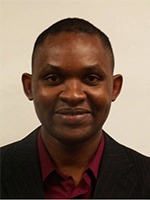Radiation as a Biological Rather Than a Physical Tool to Combat Cancer
A McNamara1*, J Eley2*, S Bright3*, W Ngwa4*, (1) Mass General Hospital and Harvard Medical School, Boston, MA, (2) Vanderbilt University School of Medicine, Nashville, TN, (3) UT MD Anderson Cancer Center, Houston, TX, (4) Brigham and Women's Hospital, Boston, MA
Presentations
10:35 AM Cellular Targets of Proton Radiation-Induced Bone Fractures - A McNamara, Presenting Author
11:00 AM Minibeam Therapy With Protons and Heavy Ions to Treat Brain Cancers - J Eley, Presenting Author
11:25 AM A Physics Approach To Combine Radiotherapy With Molecularly Targeted Therapies to Preferentially Radiosensitize Tumors but Not Normal Tissues - S Bright, Presenting Author
11:50 AM Radio-Immunotherapy Dose-Painting - W Ngwa, Presenting Author
12:15 PM Q&A & Panel Discussion - G Sawakuchi, Presenting Author
TU-AB-TRACK 5-0 (Tuesday, 7/27/2021) 10:30 AM - 12:30 PM [Eastern Time (GMT-4)]
Advances in radiation therapy (RT) have been driven mainly by technologic developments that enable precise delivery of ablative radiation doses to tumors while sparing adjacent critical structures. Substantial advances in RT technology, particularly in image-guided RT, over the past decade have paved the way for escalating radiation doses to levels that were historically inconceivable. However, dose escalation is subject to physical limits, and it cannot combat radioresistance in many tumors. The current "brute force" approach, in which delivering higher radiation doses to tumors creates more DNA damage and thus kills more tumor cells, neglects the vast knowledge accrued on the biology and immunology of tumors and normal tissues in response to radiation. This session highlights new advances with a focus on the biological rather than the physical aspects of radiation. Topics covered include mechanisms of proton-induced bone fractures; minibeam therapy using protons and heavy ions; combinations of radiation and DNA-repair inhibitors for radiosensitization and for antitumor immunity; and radio-immunotherapy dose-painting. The hope is that this session will encourage, motivate, inspire, and guide physicists to assume leading roles, rather than secondary ones, with regard to biological research applied to radiotherapy.
Learning objectives:
1. Understand and discuss opportunities for physicists in biological research applied to radiotherapy.
2. Highlight how original physics ideas can help to create biological hypotheses.
3. Encourage, motivate, inspire, and guide physicists to take a leading role rather than a secondary one on applying biological research to radiotherapy.
Funding Support, Disclosures, and Conflict of Interest: Dr. Sawakuchi's research was supported in part by RP170040, 1R21CA252411-01, Emerson Collective, MD Anderson Cancer Center. Dr. Sawakuchi has research agreements with Alpha Tau Medical and Artios Pharma.
Keywords
Radiobiology, Radiosensitivity
Taxonomy
TH- Radiobiology(RBio)/Biology(Bio): RBio- general
Contact Email











